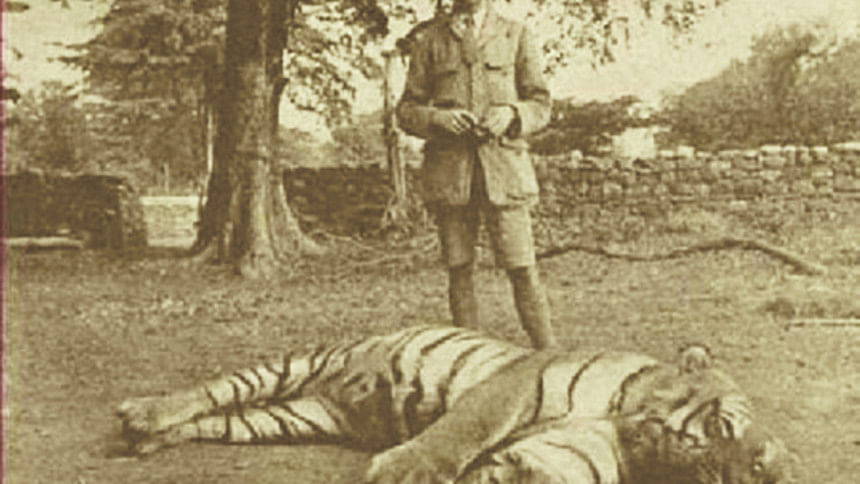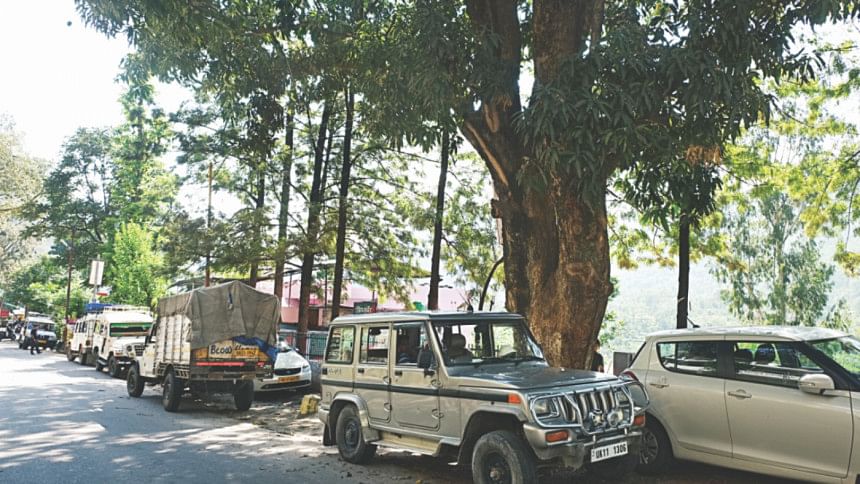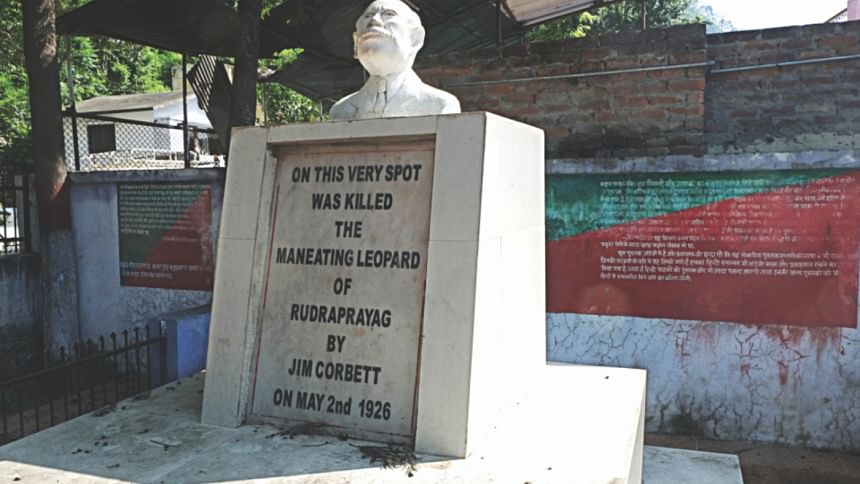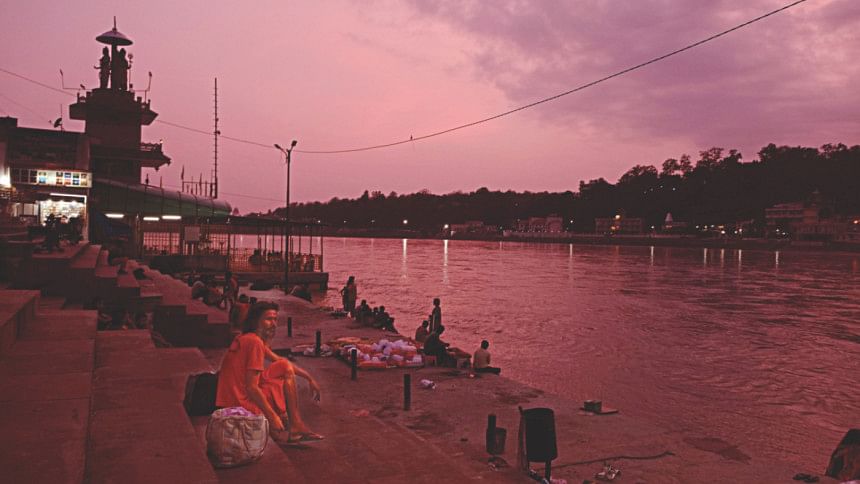Jim Corbett's leopard trail

I could swear it was the same market and the same bridge where the man-eating leopard used to stroll 90 years ago after the dusk had fallen.
The villagers in this vast Garhwal forest range in northern India would tremble at night in fear of this predator they believed was no mortal being but an evil spirit; and a fearless hunter, Jim Corbett, would follow it month after month, almost to the point of extreme exhaustion to put a bullet through the leopard's skull.
It is the most famous leopard in history. After all, in eight years during 1918 and 1926 it had killed 125 humans not counting those who later died of wounds.
Today, the market is full of shops of every odd kind-- juicewallahs, bakers, grocers, sariwallahs and so on and so forth. I am sure in Jim Corbett's time it was a mere square squatted by a few sobjiwallas and chawallas under the banyan trees.
A hundred four-wheel drive vehicles, shoe-box shaped buses and motor bikes cross the bridge every day.

The treacherous narrow and winding road that I followed to arrive here on a taxi and then on a shoebox bus was the same pilgrim road that Corbett had mentioned in his book “The Man Eating Leopard of Rudraprayag”.
Pilgrims used to walk up to Kedarnath for months on this route and rested in open sheds at night. This outsized male leopard found an easy prey in them and developed a taste so great that it would enter the villages at will, go from one house to another, scrape open the doors and snatch away anyone it could get its paws on.
I was thinking of Corbett -- his frustrations, despair and extortion for not being able to kill the leopard, one of the most ferocious and infamous for its unimaginable trickery and courage -- as my car rolled down the hills from Mussoorie.
The view by this road was breathtakingly beautiful. High mountains thick with pine and beech, mangoes and oak met the eyes all the way down.
But soon I was reminded that I came in a wrong season. The overcast sky bore down sadly on Uttarkhand. Then the distant rolls of thunder echoed around the hills. The rain began. The heaviest of monsoon rain in Bangladesh was put to shame and my taxi stopped dead on its way.

Through the hazy window all I could see was an unending line of cars until the queue took a 120 degree turn between two mountains.
Hours later we were still there struck by a landslide. I tried to scout around and saw two cars -- one Maruti Swift and a Hyundai Santro -- lying by the road, all rumpled on impact of the falling rocks.
I lay low inside my car in fear of falling rocks and munched on biscuits I brought from Dehradun. The car FM talked of some 22 tourists missing in the landslide.
I went to sleep, listening to the rain drumming on the car roof and the bulldozers raving up and down clearing the impossible chunks of solid stones. Outside everything vanished in a whiteout as cloud hung low.
…..
The next day I was in Rishikesh.
Sadhus clad in saffron dhoti were walking down the pilgrim road towards this great holy place.
I met Ajay. His long scraggly beard flew freely and his long thick moustache stuck out like a used brush. His fingers and toes were all crooked and cracked from hard living, cold, long walk and drug use. Ajay had been on his return journey from Kedarnath and walking for the last two months with his friend.
I sat with him by the Ganges on the Rishikesh Ghat in the gathering darkness of the evening, listening to how Lord Shiva received the enraged goddess Ganga on his head and let her drip slowly to save the earth to become the world's seventh largest river flowing through Bangladesh as the mighty Padma until pouring into the Bay of Bengal.

Bells rang in the temples. I could hear the holy chants. Sadhus sat motionless on the steps of the Ghat and just look at the crimson sky. People come in groups and offer their Araati. The fulwallahs and candlewallahs got busy selling their flowers and lights.
I walked through the narrow alleys of Rishikesh in deep enchantment with whiffs of burning incense sticks wafting into my nose. This is the famous Tapovon of India, the place of tapassa or meditation. Cows walk freely on the narrow alleys and you have to find our way without disturbing them to walk through. Small shops sell all kinds of things from malas to deities to mouthwatering food. Hotels have sprung up along the narrow alleys.
It is here that the pilgrims used to gather from Badrinath and take purifying bath in the holy Ganga. Then walk to Kedarnath. Rudraprayaga is somewhere in the middle where this leopard would wait for its preys.
And the sadhus often had to face ire of the people who were so distraught by the man eater that they were led to think that the sadhus would transform into the leopard and eat people.
One night, they seized the hut of a sadhu after somebody reported that he was seen leaving at the dead of the night only to return hours later with blood dripping from his mouth. That same night the leopard had killed a woman.
So the villagers set the sadhu's house on fire and burned him alive.
Another sadhu was about to face the same fate but he survived after the local administrator, a British officer, saved him from the angry crowd.
The Ganges as we know in Bangladesh has a very different appearance in Uttarkhand. In Bangladesh it enters as a placid, huge river, reflecting the plainness of the land. Your heart finds a kind of calmness by its sight. Like a goddess in meditation.
But here it is frivolous. It is like a dancing girl hopping from one stone to another, turning and twisting its waist at sharp bends. You hear its laughter as it gushes through narrow gullies.
All along the pilgrim way, the Ganges will never leave you.
And here I sit on the balcony of the hotel in Rudraprayag in the evening and watch the magical Ganges take birth, every moment, right in front of me.
Two rivers -- Mandakini and Aloknanda -- were gushing in and converging to create the Ganges. Ganga looked too narrow here, impossible to imagine its metamorphosis in the Padma.
Mandakini and Aloknanda have created a triangular wedge of the hill and here just by the fast flowing water stood a temple. On its square sat some sadhus who sang bhajan in sonorous voices.
A little later the lights went out and the stars came out. The mountain ridges crated a distinct line between the heaven and the earth, and the bhajan and the gush of the river mingled to create another song. A song of a faraway land. A song long forgotten but always alive.
That night I visited the bazaar and crossed the bridge where the leopard strolled in search of its preys. Finding nothing it would then lope off to the hills and enter the villages.
Today nothing could suggest the shivering neighbourhood. The place was bustling with every kind of activities. Hotels offered thalis. People high with marijuana happily ramble around.

I thought of walking to Golabrai, the place where Corbett had finally killed the leopard. The hotel owner said it was only one and a half kilometer from the town.
But in the morning it rained and I had to abandon the dreamy idea of a hike through the village road and rather take a car. By this road was a village which the leopard repeatedly visited and picked its prey.
Here lived a Pundit who used to give shelter to the pilgrims. One night he felt suffocated because ten pilgrims were sleeping in his room and so we went out to catch some fresh air.
As he stood on the veranda, the leopard gripped his throat. The Pundit kicked the leopard with all his force which dislodged the animal.
As he was still reeling from the attack, the leopard made a second attempt and grabbed his hand with claws. The Pundit yanked his hand with full force. That did not dislodge the claws but his flesh came off from the arm all the way to his wrist.
That saved the Pundit but at a great cost. And he was one of the two humans who survived the leopard's attack.
My car revved up the hill through a metal-led road. My heart sank; so much has changed since Corbett's time. There is no village dirt road today. And shops and hotels have replaced the villages.
The busy road took me to a taxi stand.
“Here it is,” the driver said. “Jim Corbett.”
“Where?”
“There,” the driver pointed to a pink-walled triangle, hardly visible beyond the parked taxis. Then I noticed the ancient mango tree.
On this final night, Corbett made his machan on this same mango tree 90 years ago below the village because he had noticed the leopard had come to this side of the hill. He then warned the Pundit to stay in with the 150 pilgrims that had arrived at his place.
He tied a goat 20 feet away and waited. It was a dark night and all he had to depend was his superb hearing power. Finally he knew the man-eater had arrived. There was a sudden rush beneath his mango tree as the leopard shot toward the goat.
Corbett switched on the electric torch tied to the barrel of his rifle and pressed the trigger without thinking. As the echo of the shot died away, the Pundit came out of his hut. Soon the villagers started coming out with burning torches. They would not believe the leopard, the evil spirit that had terrorized the Garhwal hills, had finally died.
Through a narrow iron gate I got inside the triangle to find a white concrete pedestal. “On this very spot was killed the man-eating leopard of Rudrapayag by Jim Corbett on May 2nd 1926,” reads a plaque. On top of it is the bust of Corbett.
I stood there and turned my head towards the mango tree. Twenty feet away it stood alright. Then I looked beyond in search of the Pundit's hut. No trace of it. In place was lined a row of hotels.
I took a last look at Corbett, then left this humongous of a man behind and headed for Kedarnath.

 For all latest news, follow The Daily Star's Google News channel.
For all latest news, follow The Daily Star's Google News channel. 



Comments